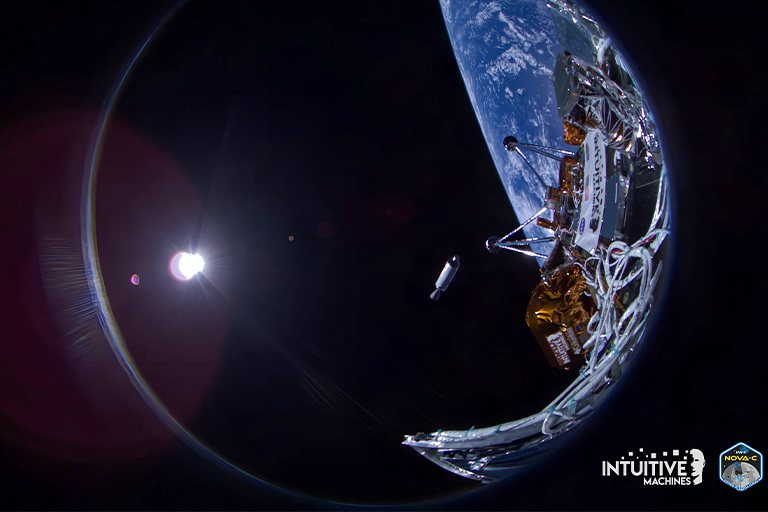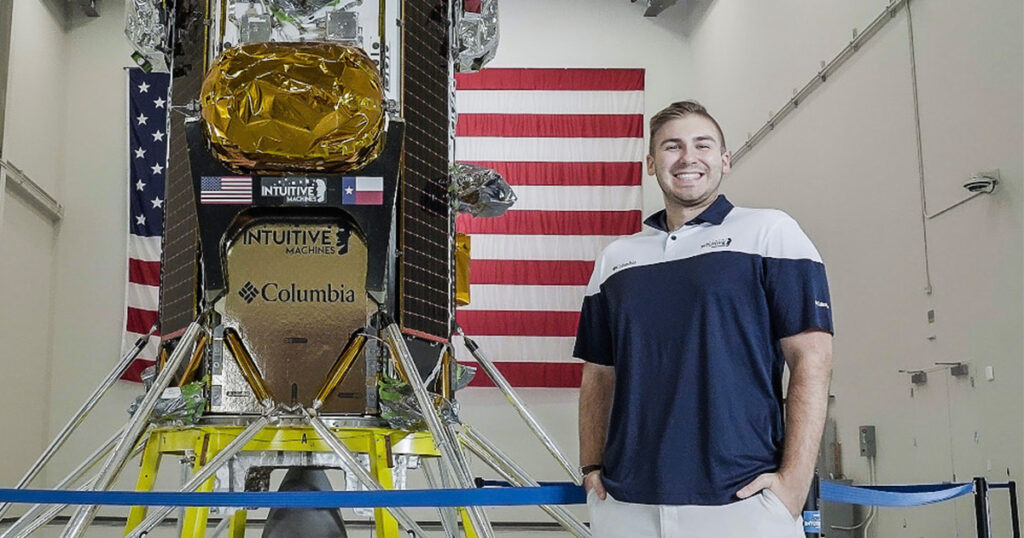Tickle College of Engineering alumnus Christopher Busic said he felt a sense of awe watching Odysseus, the robotic lunar explorer built by Houston-based Intuitive Machines, land on the surface of the moon on February 22.
Odysseus, or “Odie” as it was affectionately known, was the first commercial spacecraft to land on the Moon and the first U.S. Moon landing in over 50 years. And Busic played a role in making it happen.
Busic, who received his bachelor’s degree in aerospace engineering in 2021, is now a guidance and control engineer at Intuitive Machines. Founded in 2013, Intuitive Machines is one of NASA’s Commercial Lunar Payload Services (CLPS) providers, which carry cargo for NASA and other private customers to the Moon.
Busic said his role involved assessing Odysseus’s guidance and control performance both prior to and during flight via high-fidelity simulation.

Odysseus’ landing strut during landing on February 22 performing its primary task, absorbing first contact with the lunar surface.
Although Busic wasn’t born when Apollo 17 landed on the moon in 1972, he’s studied documentaries about past space missions.
“Knowing we were standing on the shoulders of giants and building on that rich history of space travel was profound,” he said.
In the aftermath of Odysseus’ lunar landing, Busic emailed TCE Dean Matthew Mench, the Condra Chair Professor and a Chancellor’s Professor of mechanical, aerospace, and biomedical engineering (MABE).

Odysseus approximately 30 meters above the lunar surface at the south pole region of the Moon.
“It’s been three days since I had the opportunity of a lifetime—to witness a spacecraft I had worked on land on the lunar surface,” Busic wrote. “My experience within the MABE department played a pivotal role in me getting to where I am today.”
Busic said UT faculty urged him to engage in undergraduate research, participate in NASA competitions, and be active in the American Institute of Aeronautics and Astronautics (AIAA) student branch. He had summer internships at Leidos Dynetics in Huntsville, Ala., and a senior-year internship at Mclaurin Aerospace in Knoxville.
When it came to working with Intuitive Machines, those experiences ”really set me up to diversify myself from other candidates,” Busic said.
Busic, who grew up near Houston, interned at Intuitive Machines the summer before starting graduate school at the University of Texas, Austin. The company provided him with research funding during his studies and hired him upon graduation.
Busic said Odysseus, which was carried into space by the SpaceX Falcon 9 rocket, proved that an unmanned craft could land on the moon—important because it’s less expensive and less dangerous than sending humans into space.
Odysseus had a 3D-printed engine. It also was the first spacecraft to be powered by liquid oxygen and liquid methane, which are cleaner and less toxic than other propellants.

Odysseus captures first images of Earth shortly after separation from SpaceX’s second stage.
In addition to hauling NASA experiments, Odysseus carried Embry-Riddle Aeronautical University’s miniature satellite camera system, the first student-built project to land on the moon, the first to capture third-person imagery of a spacecraft, and the first to use WiFi on the lunar surface. Odysseus also carried commercial payloads, including Columbia Sportswear, which tested the limits of the sportswear company’s innovations by sending Omni-Heat™ infinity to the Moon to protect the Nova-C lunar lander from the extreme temperatures of outer space. Odysseus also carried 125 small sculptures of the moon by artist Jeff Koons that were placed on the lunar surface. Here on Earth, art-lovers bought physical copies of the sculptures and non-fungible tokens (NFTs), or digital art pieces, that mirror those on the moon.
Busic said it’s an exciting time to work in the aerospace industry because of the “revived interest in exploring the unknown” and the need for innovative ways to “fill the needs that will continue to arise now that we are open for business on and around the Moon.”
